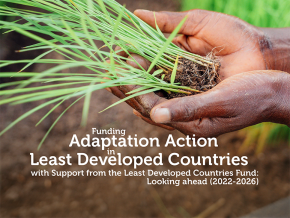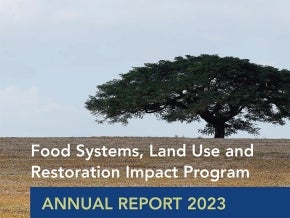
Lake Tota, the largest lake in Colombia, is surrounded by highest-altitude farmlands that are unlocking secrets about how to manage water resources in a time of climate crisis.
Located at 3,000 meters above sea level, the Lake Tota basin produces 70 percent of the green onion grown in Colombia and has in recent years seen an increase in population, agricultural activity, and industrial growth. These trends have driven up demand for water supplies at the same time as climate change is making a mark in the area, threatening the availability of water for both agriculture and human consumption.
Such challenges are not unique to this area, and lessons from a climate change adaptation project stretching across four Andean countries has provided data-driven guidance with relevance to highland communities around the world who are seeking to better-manage strains on water cycles for a more sustainable future.
This is the main goal of the Andes Adaptation to the Impacts of Climate Change on the Water Resources Project (AICCA), supported by the Global Environment Facility, GEF-managed Special Climate Change Fund, CAF – the development bank of Latin America, and CONDESAN - Consortium for the Sustainable Development of the Andean Ecoregion, together with the environment ministries of Bolivia, Colombia, Ecuador, and Peru.
The initiative is helping to generate a robust base of scientific information about the water cycle and develop an analysis for territorial adaptation.
The collected hydro-meteorological information, together with climate variability and change scenarios developed by the project team, yielded insights on the impacts on the hydrological cycle of the basin. Based on those inputs, a vulnerability analysis was carried out to analyze the elements and sectors most at risk from scarcity, the conditions that make them susceptible, and those that could reduce these impacts.
An important part of this work was an analysis of the ecological structure of the basin, including the set of biotic (living) and abiotic (non-living) elements supporting the essential ecological processes of the territory and their exposure to climate change. From there, the team defined climate adaptation measures that could help conserve, connect, and manage the ecosystem and its components.
The team also mapped threats related to the availability of water and food security across the basin, including drought, soil erosion, changes in agrobiodiversity, deterioration of natural ecosystems, and impacts on livelihoods. Climate adaptation options related to natural systems, productive activities, and community governance were also identified in partnership with local stakeholders, said Lorena Martinez, an environmental technician with the AICCA project.
“We worked closely with the community, reviewing maps with different layers that confronted us all with the reality of challenges to the health of ecosystem services as well as the effects of climate change. Having this specific knowledge is a critical piece of making progress on cementing climate adaptation processes,” Martinez said.
These research efforts resulted in the identification of seven priority adaptation measures: (1) sustainable tourism, (2) rainwater harvesting, (3) phenological bird monitoring, (4) apiculture production systems, (5) ecological restoration, (6) seed recovery at a high mountain germination center, and (7) participatory meteorological monitoring. Each was evaluated based on its effectiveness, gender balance focus, and expected benefits including to local livelihoods and communities.
Restoration actions were then carried out in four areas where the paramo (Andean alpine tundra) ecosystem predominate. In support of seed recovery, a high mountain germination center was established to recover, propagate, and maintain species that are important for extreme climate contexts, for example the encenillo (Weinmannia tomentosa), canelo (Drimys granadensis) and maíz tostado (Myrsine dependens).

Luis Rodriguez, a forest engineer with the civil society organization Bosque Nativo, said the high mountain germination center was a major asset for the communities and institutions of the Lake Tota Basin. “They will not only find native species, they will also be able to learn how to identify the seeds, collect and handle them until they achieve healthy seedlings, which can then be used in ecological restoration processes,” Rodriguez said.
To support more sustainable agriculture production, different approaches were implemented according to the climatic threats identified in the four municipalities of the basin (Cuítiva, Tota, Sogamoso, and Aquitania). For example, in areas that would be most affected by increases in temperature and changes in water availability, rainwater harvesting systems were established to cushion these changes. Likewise, sustainable tourism and apiculture production systems were proposed to diversify livelihoods and increase the adaptive capacity of communities settled in places where productive soils stand to be most affected by climate change.
The project also illustrated the importance of community governance for adaptation, through for instance local participatory platforms, consensual decisions, the identification of synergies, and the design of new adaptation strategies over time.
The AICCA project team worked closely with knowledge communities and local thematic groups to design adaptation solutions. A broad call was made in the different municipalities of the basin so that interested people could participate in the initial workshops. Eight groups emerged, focused on ancestry, gender relations, environmental education, analysis of governance conditions, socio-environmental vulnerability, productive processes in the area, proposals for sustainable tourism, and the use of alternative energies for water access.
The knowledge and experiences generated through this initiative have also contributed to the inclusion of climate change criteria into various policy instruments. Specifically, this has occurred in plans for the integral management of the basin and in municipal plans for land use, water concessions, and rural extension programs.
At the same time, officials in local governments as well as local community members have learned more about these issues and how to manage them. These effects have generated a more favorable environment for climate adaptation across the basin that stand to be further built on and strengthened in the coming years.
Luz Helena Hernandez, a social technician with AICCA, said she expects the positive effects to continue well beyond the life of the project. “Because of the data and knowledge the people of the territory have access to, we expect that climate adaptation processes will continue in this area and in others after the AICCA project completes its activities,” she said.


